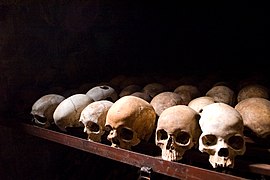Akazu
 |
| Part of a series on the |
| Rwandan genocide |
|---|
The Akazu (Kinyarwanda: [ɑ.kɑ.zu], little house) was an informal organization of Hutu extremists whose members contributed strongly to the 1994 Rwandan genocide. A circle of relatives and close friends of Rwanda's then-president Juvénal Habyarimana and his influential wife Agathe Habyarimana,[1] they were also called the Zero Network, for their goal of a Rwanda with zero Tutsi.[2][3]
Background
The Akazu were relatives of Habyarimana's and others he knew from his Northern Rwanda district; they held important appointed positions of authority in the Hutu regime. The Akazu did not wish to share government with the Tutsis (particularly the expatriate rebels resident in Uganda) or moderate Hutu. They contributed to the development of Hutu Power ideology and fanned resentment against the Tutsi during the 1990s. Some scholars believe their genocidal ideology and massacres were an effort to hold on to the political power they had gathered since Habyarimana came to power in a military coup against the elected government.[4]
Known members
- Protais Zigiranyirazo, former governor of the Ruhengeri prefecture[1]
- Seraphin Rwabukumba, brother-in-law of President Habyarimana[1]
- FAR Colonel Elie Sagatwa[1]
- FAR Colonel Théoneste Bagosora[1]
- FAR Colonel Laurent Serubuga
- Félicien Kabuga, businessman who was the primary financier[5] of the RTLM radio station and Kangura magazine
- Agathe Kanziga, First Lady of Rwanda
- Séraphin Bararengana, head of the Department of Medicine at the University of Rwanda; brother of President Habyarimana
- Charles Nzabagerageza, businessman and shareholder in RTLM radio[6]
- Alphonse Ntirivamunda, son-in-law of President Habyarimana
- Joseph Nzirorera, former speaker of the National Development Council and Minister of Industry, Mines and Handcraft[7]
- Noel Mbonabaryi, uncle of President Habyarimana[8]
- Pauline Nyiramasuhuko, Minister for Family Welfare and the Advancement of Women in Habyarimana's government from 1992
External links
- www
.preventgenocide .org /edu /pastgenocides /rwanda /resources - https://books.google.com/books?id=ceFIryEHTL4C&dq=members+akazu&pg=PA105
References
- ^ a b c d e Des Forges, Alison (March 1999). Leave None to Tell the Story: Genocide in Rwanda – History → The Army, the Church and the Akazu. New York: Human Rights Watch. ISBN 1-56432-171-1.
- ^ Propaganda of the Rwanda genocide: Glossary, archived from the original on 7 January 2015
- ^ 15 Years after the Rwandan Genocide: Hutu Power and its Friends, Jungle World, 2 April 2009/
- ^ De Figueiredo & Weingast. (1999). "The rationality of fear: Political opportunism and ethnic conflict", in (eds.) Walter & Snyder, Civil Wars, Insecurity and Intervention, New York: Columbia University Press, p. 261.
- ^ "MICT-13-38". United Nations International Residual Mechanism for Criminal Tribunals. 2013-11-11. Retrieved 2020-06-04.
- ^ Zarembo, Alan (1995-11-27). "PAGE ONE -- Exiled Hutu Elite Keeping Hate Alive". SFGATE. Retrieved 2023-02-11.
- ^ "Tribunal Begins Two Trials | United Nations International Criminal Tribunal for Rwanda". unictr.irmct.org. Retrieved 2023-02-11.
- ^ Wallis, Andrew (2020-04-08). "Rwanda's Forgotten Years: Reconsidering the Role and Crimes of Akazu 1973–1993". Journal of International Peacekeeping. 22 (1–4): 40–59. doi:10.1163/18754112-0220104004. ISSN 1875-4112. S2CID 218800967.